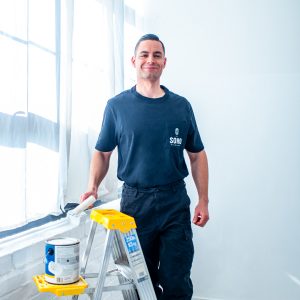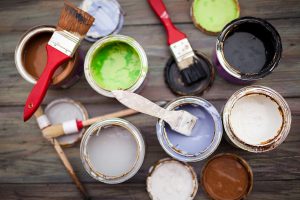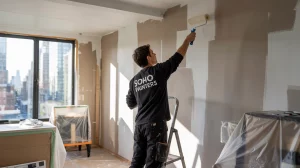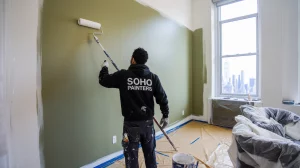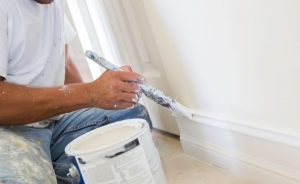Wood can be a versatile material for incorporating into your home as you can use it to make trims, sidings, fences, or furniture. But because of its porous nature, it can be challenging to work with during rainy or winter seasons.
Since moisture can take a while to dry out of wood, you’ll need to set aside painting your projects until it’s completely dry.
But in cases where you need to finish a home project urgently, is it possible to paint damp wood?
What happens if you paint damp wood?
Wood should be fairly easy to paint but in cases where moisture has overtaken your project, it’s best to wait until it’s completely dry as painting damp wood will create a series of problems that will affect the longevity of your material.
Since paint creates a seal over the wood, the moisture won’t be able to dry out. Over time, this will encourage mold to grow within its core, causing it to rot faster than it’s supposed to.
But if you’re in a pinch and need to paint your project immediately, damp wood is possible to paint – you just need to use the right type of paint to get a decent result.
Can you paint damp wood with oil-based paint?
If you’re taking the risk of painting damp wood, it would be useful to know what type of paint you’ll need to use.
Considering oil doesn’t mix well with water, using oil-based paint on damp wood won’t give you the most durable results. Since the oil will repel the moisture that’s inside the wood, the paint won’t get absorbed into its surface. This will make the wood chip faster, so you’ll need to re-apply paint more often.
This won’t be ideal if the wood is part of your interior walls, as the hassle of re-painting trims or sidings will take a toll on your time and budget in the long run.
Can you paint damp wood with water-based paint?
The trick to getting a better outcome for painting damp wood is to use water-based paints as this will have a better chance of mixing with the wood’s moisture. So any color of acrylic or latex paint will get better results than oil-based paints would.
But don’t expect the paints to last as long as they would on dry wood, as they won’t get absorbed that deeply into its surface. So you’ll still see chips and peels sooner than you’ll expect.
That’s why it’s always better to dry your project first before attempting to cover it with paint.
How long should wood dry before painting?
The time it will take for damp wood to dry completely will depend on its size and thickness. Some will only take a day, while others can take about 72 hours up to a week.
So if you were planning on cutting your material into smaller pieces, it’s better to do it now to make the drying process faster.
If you’re going to paint wooden furniture, you can also take apart any attachments – like doors and drawers – to ensure every surface dries up.
This process can be tedious, but the results of painting on dry wood will be worth it.
What should the moisture content of wood be before painting?
To get the best paint finish, you need to wait for the wood to have 12% moisture left if it’s for interior walls, 13% for exterior walls, and 6% for furniture.
But since it can be difficult to test that through touch alone, the best way to know is by using a moisture meter. This will allow you to find out how much moisture is still inside the wood’s core since some materials may have their exterior surfaces appear dry – but still have some moisture left inside.
Moisture meters can be pricey, but they can also be a valuable addition to your set of tools. So if you’re ready to splurge on one, they’re available online or through your nearest hardware store.
How do you dry out damp wood?
Drying damp wood can take time that not everyone has so if you want to speed up the process, here are a few tricks you can do:
Dehumidifier
A dehumidifier is an electric device that removes moisture in the air, so it can be useful for drying damp wood.
The only catch is you’ll need to have a dehumidifier that’s powerful enough to dry your material. So if you’re trying to dry the wooden sidings on your wall, you might need a large dehumidifier or multiple units to speed up the process.
Airdry
The fastest way to dry wood is to use heat, but since it won’t be practical to start a fire to dry walls or wooden windowsills, the next best thing to do is to airdry your material.
Similar to the dehumidifier, you’ll need an electric fan that’s powerful enough to dry its entire surface. So you can use one large unit or multiple fans at the same time. If the weather is windy, you can also take advantage by bringing out damp wooden furniture or by opening windows.
How to paint damp wood
Letting the wood dry completely before painting is always recommended, but if you’re in a hurry there is a quick way for painting its damp surface.
The first rule for painting damp wood is to allow it to dry as long as possible. So if you’re painting your walls and trims, it might be a good idea to paint your walls first in this situation to allow the wooden trims to dry out longer.
Next, you’ll need to use a foam roller for painting as this won’t pick up as much paint, so you’ll get a thinner coat that will allow the surface to dry faster.
Apply an even layer of your water-based paint and let it dry completely before applying the 2nd coat.
But if you want to get professional results on your project, you can contact Soho Painters to know more about their services.

